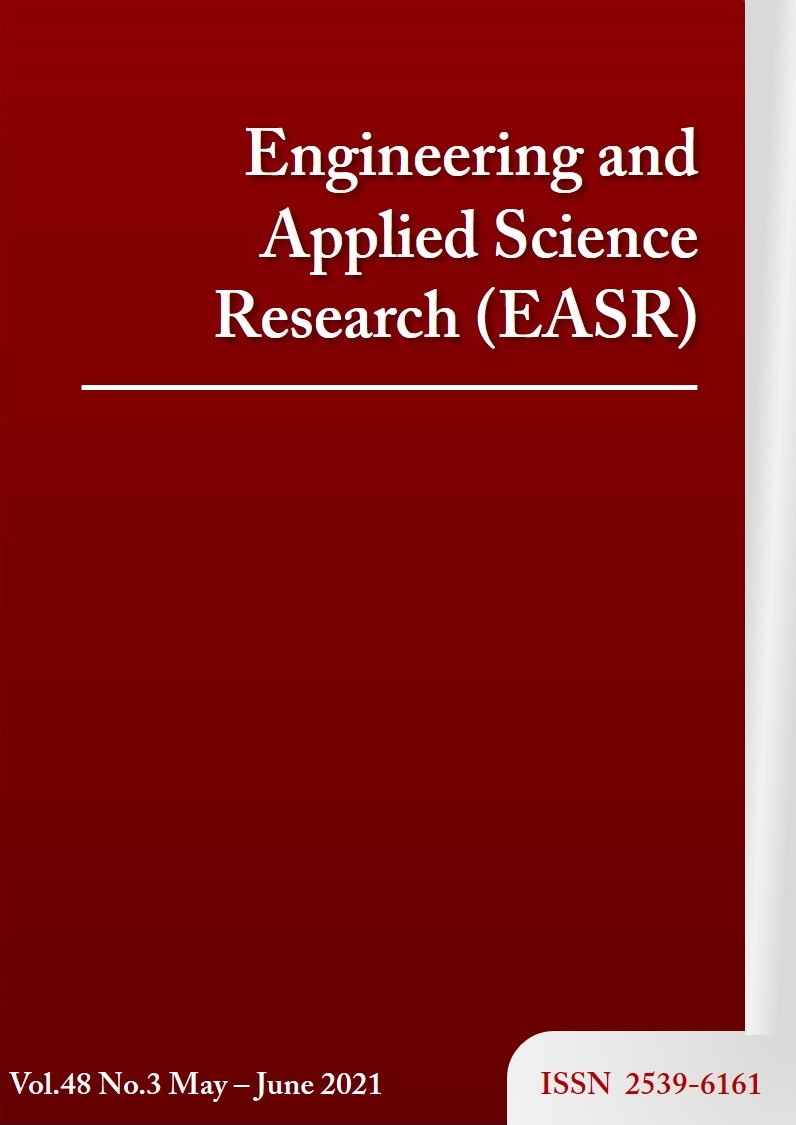Identifying “puff” characters in the figure-ground formation of the simulated patient’s visual experience
Main Article Content
Abstract
This study addresses the limitation of patients’ visual experience in a healthcare environment. Clarity of visual experience occurs within the visual sphere that represents the seeing capacity defined by focus and peripheral view. The visual sphere is formed by the collections of “puff”- the unidentified parts as the components that create the wholeness of form in visual perception. This paper argues that the characters of puffs and their relationship could play an essential role in the formation of figure and ground. A simulation study was conducted by capturing the perceived scenes in a simulated patient room and then analyzing the character of regions in the scenes and their level of relationship. The study displayed the relationship between the region's position and the region's characters that form the integrity of the whole visual scenes. Knowledge of this relationship indicates that puff identification can be useful for evaluating the potential architecture elements within the visual capacity.
Article Details
This work is licensed under a Creative Commons Attribution-NonCommercial-NoDerivatives 4.0 International License.
References
Koffka K. Principles of Gestalt psychology. Oxfordshire: Routledge; 2013.
Trancik R. Theories of urban design. Finding lost space. 1st ed. New Jersey: Wiley; 1986.
Peikoff L. Objectivism: The philosophy of Ayn Rand. USA: Penguin; 1993.
Koenderink J, Doorn Av. The planispheric optic array. i-Perception. 2017;8(3):1-7.
Sengke MMC, Atmodiwirjo P, Yatmo YA, Johanes M. Design consideration for window placement to provide the view within the patient's visual range. J Des Built Environ. 2020;20(1):13-23.
Mancini F, Longo MR, Kammers MP, Haggard P. Visual distortion of body size modulates pain perception. Psychol Sci. 2011;22(3):325-30.
Nanda U, Chanaud C, Nelson M, Zhu X, Bajema R, Jansen BH. Impact of visual art on patient behavior in the emergency department waiting room. J Emerg Med. 2012;43(1):172-81.
Felippe ML, Kuhnen A, da Silveira BB, Lelli G. What is a restorative hospital environment? Environmental meaning, affective stress restoration and physical attributes in pediatric inpatient rooms. Child Youth Environ. 2017;27(1):17-46.
Ulrich RS. View through a window may influence recovery from surgery. Science. 1984;224(4647):420-1.
King DB, Wertheimer M. Max Wertheimer and gestalt theory. USA: Transaction Publishers; 2005.
Kohler W. The task of Gestalt psychology. USA: Princeton University Press; 2015.
Jackson WJ. Heaven’s fractal net: retrieving lost visions in the humanities. USA: Indiana University Press; 2004.
Artal P. Handbook of visual optics. USA: CRC Press; 2017.
Askari AH. Influence of building facade visual elements on its historical image: Case of Kuala Lumpur, Malaysia. J Des Built Environ. 2009;5(1):49-59.
Carbon CC, Mchedlidze T, Raab MH, Wachter H. The power of shape: How shape of node-link diagrams impacts aesthetic appreciation and triggers interest. i-Perception. 2018;9(5):1-18.
Ieosanurak W, Klongdee W. Face recognition and verification based on 2D circle technique. Eng Appl Sci Res. 2016;43(S2):213-6.
De Kerckhove D, Lumsden CJ. The lateralization of writing. In: Kerckhove D, Lumsden CJ, editors. The alphabet and the brain. New York: Springer; 2013.
Kaewpontong N, Limsiroratana S. Image matching with multi medium Delaunay triangulation. Eng Appl Sci Res. 2016;43(S1):26-8.
Kesorn K, Phawapoothayanchai P. Optical character recognition (OCR) enhancement using an approximate string matching technique. Eng Appl Sci Res. 2018;45(4):282-9.
Sebeok TA, Umiker-Sebeok DJ. Advances in visual semiotics: The semiotic web 1992-93. 118th ed. Berlin: Walter de Gruyter; 1995.
Metzger W, Spillmann LT, Lehar ST, Stromeyer MT, Wertheimer MT. Laws of seeing. USA: MIT Press; 2006.
Pallasmaa J. The eyes of the skin: Architecture and the senses. 3rd ed. New Jersey: Wiley; 2012.
Yang J. Vision facts: Questions about the human eye. USA: Universal Publishers; 2018.
Savino PJ, Danesh-Meyer HV. Color atlas and synopsis of clinical ophthalmology-Wills eye Institute-Neuro-Ophthalmology. USA: Lippincott Williams & Wilkins; 2012.
Herman I. Physics of the human body. New York: Springer; 2007.
Belfiore A, Palmieri VO, Palasciano G. Art in hospital: is it possible?. Ital J Med. 2015;9(1):89-91.
Ho RT, Potash JS, Fang F, Rollins J. Art viewing directives in hospital settings eRect on mood. Health Environ Res Des J. 2015;8(3):30-43.
Schreuder E, Lebesque L, Bottenheft C. Healing environments: What design factors really matter according to patients? An exploratory analysis. Health Environ Res Des J. 2016;10(1):87-105.
Chua SH, Perrault ST, Matthies DJ, Zhao S. Positioning glass: investigating display positions of monocular optical see-through head-mounted display. Proceedings of the Fourth International Symposium on Chinese CHI; 2016 May; San Jose, USA. USA: ACM; 2016. p. 1-6
Wiese W. Experienced wholeness: integrating insights from gestalt theory, cognitive neuroscience, and predictive processing. USA: MIT Press; 2018.
Lawton T, Shelley-Tremblay J. Training on movement figure-ground discrimination remediates low-level visual timing deficits in the dorsal stream, improving high- level cognitive functioning, including attention, reading fluency, and working memory. Front Hum Neurosci. 2017;11:236.
Veras QCP Christine, Maus GW. The silhouette zoetrope: a new blend of motion, mirroring, depth, and size illusions. i-Perception. 2017;8(2):1-8.
RabinoR E. Perception in Aristotle’s ethics. USA: Northwestern University Press; 2018.
Gallace A, Spence C. To what extent do Gestalt grouping principles influence tactile perception?. Psychol Bull. 2011;137(4):538.
Kimchi R. The perceptual organization of visual objects: A microgenetic analysis. Vis Res. 2000;40(10-12):1333-47.
Palmer SE, NeR J, Beck D. Late influences on perceptual grouping: Amodal completion. Psychonomic Bull Rev. 1996;3(1):75-80.
van den Berg M, Kubovy M, Schirillo JA. Grouping by regularity and the perception of illumination. Vis Res. 2011;51(12):1360-71.
Wagemans J, Elder JH, Kubovy M, Palmer SE, Peterson MA, Singh M, et al. A century of Gestalt psychology in visual perception: I. Perceptual grouping and figure-ground organization. Psychol Bull. 2012;138(6):1172.
Bernstein A. Before interpretation. Univ Chicago Law Rev. 2017;84(2):567-653.
Dobbins AC, Grossmann JK. Asymmetries in perception of 3D orientation. PLos One. 2010;5(3):e9553.
Barberis SD. Multiple realization, levels and mechanisms. Teorema. 2017;36(2):53-68.
Delisle G, Dandeneau M. Object relations in Gestalt therapy. London: Routledge; 2013.
Turner CE, Kellogg RT. Category membership and semantic coding in the cerebral hemispheres. Am J Psychol. 2016;129(2):135-48.



